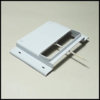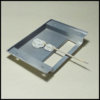S
Stevekir
Guest
I have some parts in my present model which have rounded edges and which wet after spray or airbrush painting need to be put down level on their undersides to avoid spoiling the edges. Here is a sketch which shows the problem:

(The problem also applies to similar parts with rectangular edgeds).
A typical part is essentially a rectangle of plastic about 3 mm thick. Like a lid of a box-shaped part. All four of it's top edges are rounded, including the four corners. After painting and when the paint is still wet the part needs to be put down to dry flat on a surface to dry, without the rounded edges being in contact with anything at any time. This means that the part needs to be lowered to the surface horizontally. Without a levitation machine, the problem is to avoid tipping the part so that the edge ("edge of the part" in the sketch) will not be damaged. This is most important with gloss coats. The part cannot be hand held while lowering because the hand cannot be extracted without tipping the part. (I've made a meal of this explanation to be sure it is clear.)
My usual method of holding parts to be sprayed or airbrushed is to attach a blob of white tack to the back of the part and then gingerly to put it down supported initially by an edge while I remove my hand whose fingers inevitably stick to the white tack requiring a tussle. An alternative is to hold the white tack with tweezers but they also stick. "Supported initially by an edge" is the problem.
I suppose I could build stands each consisting of two rails attached to each other and held on four legs a couple of inches above the drying surface. A blob of white tack attached to a small weight would prevent the part being blown off by the spray. The part would not need moving between spraying and being dry.
How do others put such wet parts down without damage?
(The problem also applies to similar parts with rectangular edgeds).
A typical part is essentially a rectangle of plastic about 3 mm thick. Like a lid of a box-shaped part. All four of it's top edges are rounded, including the four corners. After painting and when the paint is still wet the part needs to be put down to dry flat on a surface to dry, without the rounded edges being in contact with anything at any time. This means that the part needs to be lowered to the surface horizontally. Without a levitation machine, the problem is to avoid tipping the part so that the edge ("edge of the part" in the sketch) will not be damaged. This is most important with gloss coats. The part cannot be hand held while lowering because the hand cannot be extracted without tipping the part. (I've made a meal of this explanation to be sure it is clear.)
My usual method of holding parts to be sprayed or airbrushed is to attach a blob of white tack to the back of the part and then gingerly to put it down supported initially by an edge while I remove my hand whose fingers inevitably stick to the white tack requiring a tussle. An alternative is to hold the white tack with tweezers but they also stick. "Supported initially by an edge" is the problem.
I suppose I could build stands each consisting of two rails attached to each other and held on four legs a couple of inches above the drying surface. A blob of white tack attached to a small weight would prevent the part being blown off by the spray. The part would not need moving between spraying and being dry.
How do others put such wet parts down without damage?








